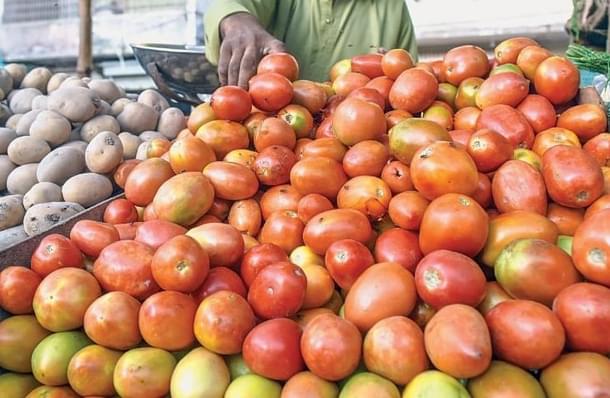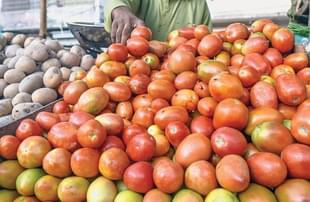News Brief
Tomato Prices Expected To Touch ₹ 300 Per Kg; Recovery By September
Yathansh Joshi
Jul 13, 2023, 03:29 PM | Updated 03:29 PM IST
Save & read from anywhere!
Bookmark stories for easy access on any device or the Swarajya app.


Tomato prices, which have recently skyrocketed, are expected to rise further, potentially reaching ₹ 300 per kg in the upcoming weeks.
This is due to a combination of incessant rains in some areas and insufficient showers in others, which have negatively impacted the production and transportation of this essential kitchen ingredient.
Agriculture experts have expressed concerns about the situation.
According to Sanjay Gupta, the Managing Director and CEO of National Commodities Management Services Limited (NCML), the problem of price rise is likely to persist for some time. Plantation of new tomato crops is not possible during the rainy season, which means prices will continue to increase in the weeks ahead.
It may take at least two months before prices start to stabilize, according to him.
Retail prices of tomatoes have skyrocketed across the country. In June, prices were around ₹ 40 per kg, but by the first week of July, they had already reached an average of ₹ 100 per kg. The heavy rainfall has further impacted the supply from different regions, causing prices to rise even higher, averaging around ₹ 200 per kg.
The major tomato-producing states in India are Andhra Pradesh, Madhya Pradesh, Karnataka, Gujarat, Odisha, West Bengal, Maharashtra, Chhattisgarh, Bihar, Telangana, Uttar Pradesh, Haryana, and Tamil Nadu. These states collectively account for 91 percent of the country's total tomato production, as reported by the Ministry of Agriculture.
According to Gupta, the current supply of tomatoes is only coming from southern and some north-eastern areas.
Erratic weather conditions have significantly disrupted tomato production in the southern and coastal regions of the country. Heavy rainfall in the Himachal area has also had a negative impact.
Furthermore, the disruption of highways and transportation has resulted in major post-harvest losses.
Tomatoes are a short duration crop that is highly sensitive to heat and susceptible to viruses, as explained by Gupta. A portion of the crop was destroyed during an early heat wave that affected large parts of India between February and March.
Additionally, two different viruses have also affected yields in Maharashtra and Karnataka earlier this year. The southern parts of the country, particularly Maharashtra, have experienced low production due to extreme heat in May and unseasonal rainfall and hailstorms in June.
Another reason for the low growth in the agricultural sector is the discouragement faced by farmers in terms of fair prices for their produce. Earlier this year in March-April, the prices for onion and capsicum crashed, causing many farmers to lose hope and stop growing vegetables, as reported by Moneycontrol.
The stabilization of tomato prices remains uncertain. Due to the heavy rains in the tomato-growing states, the usual crop cycle of 60-90 days is disrupted, making it impossible to sow new crops.
Consequently, it may take a longer time for the prices to stabilize.
Farmers generally avoid sowing tomatoes during May and June, as explained by Gupta. Only when the rains slow down will they resume sowing, which is expected to happen towards the end of July or early August in most areas.
In summary, the combination of discouraging price trends and unfavorable weather conditions has contributed to the low growth in the agricultural sector. Farmers have been hesitant to continue growing vegetables, and the heavy rains have disrupted the tomato crop cycle, delaying the stabilization of prices.
The production seasons vary across different regions, with new crop arrivals expected from Nashik district, Narayangaon, and the Aurangabad belt in Maharashtra. However, these regions have experienced deficient rainfall.
According to Gupta, the prices of crops should start stabilizing towards the end of August and early September.
Growing vegetables is a costly and labor-intensive process. It requires regular picking and pesticide spraying, unlike crops such as wheat and paddy that have fixed cultivation methods. Farmers choose to grow vegetables to support their families and have immediate cash in hand. If they do not make enough money, they can easily switch to growing a different crop.
Over the past two years, the area dedicated to vegetable cultivation has been decreasing, as noted by Gupta. This decline in supply has led to a significant decrease in the availability of all vegetables, resulting in higher prices.
There are also concerns about the possibility of onion prices rising later this year.
According to experts, the prices of onions are expected to rise during the October-November period this year. This is because the current supply is from earlier produce, and the disrupted rain cycle may have an impact in the coming months.
In order to regulate retail prices, the government has stepped in. The Department of Consumer Affairs issued an order on July 12 to procure tomatoes from Andhra Pradesh, Karnataka, and Maharashtra.
These tomatoes will be distributed in major consumption centers to help control the increasing retail prices.
Tomatoes are being collected from mandis in Andhra Pradesh, Karnataka, and Maharashtra to be distributed simultaneously in major consumption centers. These centers have experienced the highest increase in retail prices over the past month, as noted by the Ministry.
The Department of Consumer Affairs explains that aside from the usual price seasonality, temporary disruptions in the supply chain and crop damage caused by adverse weather conditions have contributed to the sudden price spikes.
The ministry further states that new crop arrivals are expected soon, which should lead to a decrease in prices in the near future.




